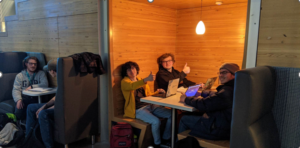AdapT Lab Cuts Down Barriers

I recently sat down with Dr. Blessinger, director of the MadLabs’ AdapT Lab, to discuss some exciting new tools. A big element to having new tools is that it changes how problems can be approached and offers previously unseen or unobtainable outcomes. The main topics of our discussion were a CNC plasma cutter and the ability for collaboration that having new equipment offers. For the uninitiated, a CNC Plasma cutter is similar to a 3D printer but with one less axis. Rather than adding materials, it makes precise cuts. This technology is typically used for cutting conductive material like metal. Blessinger mentioned that CNC plasma cutters allow for “faster and more accurate” repetitive cuts. Adding that some artists like to work with metal and this machine can offer them an opportunity for precise cutting that would otherwise be unobtainable.
The Adapt lab is a “great place where software meets hardware” as the lab director perfectly phrased it. Already the lab has shown how it is able to collaborate and bring together elements of underdeveloped hardware with the foundational software skills that are prevalent on campus. With limited off-the-shelf products for things such as powered wheelchairs, both elements are left to the consumer to navigate if they want any modifications. This leaves the door open for the lab to identify needs of the users and work with them to make their everyday use of these devices more comfortable, functional, and personalized. This inevitably involves both hardware and software development which offers many opportunities for collaboration of skills and tools. Things like wheelchair modifications are a great way of demonstrating the collaborative power of Mad Labs. A sign of a great builder is the ability to come together with other builders and use a collective of skills and tools that yields a product greater than the sum of the parts.

Something that Dr. Blessinger emphasized during our discussion was the ability of the AdapT lab to work alongside other labs for even better community outreach. Blessinger mentioned that this university is the “unquestioned leader in software” in the state and region. However, as he acknowledged, there is an untapped opportunity to complement this with hardware as well. The prominence of IOT devices today shows that combining both of these together is much stronger than relying upon only one. Going as far as to mention that he would like to see the emergence of a degree related to “smart things.” Of course, the Patriot lab shows the recognition of industry devices on campus but stops short of developing devices themselves. The security related education that is being obtained in the Patriot lab could certainly complement any hardware research produced throughout all the Mad labs.
The CybHer lab offers an opportunity for the AdapT lab to connect with K-12 students and identify developmental learning needs that can be assisted. With regular interaction with these young students they are in a perfect position to facilitate the AdapT Lab’s mission of “barrier-free-living” while also inspiring them to become interested in discovering how technology works. Both graduates and undergraduates working alongside the AdapT lab can use the knowledge gained from working with the various hardware components to teach the school children the basics of hardware and software integration. In doing so, Dr. Blessinger believes that kids can take the basic knowledge of how things like LEDs work and imagine ways to use that knowledge for personal projects. Dr. Blessinger mentioned that “even when you don’t need tools” working with other groups can be helpful for the skills and experience that can be offered instead. The open floor plan has allowed each lab to share a common ‘thinking space’ now through that shared space a concerted effort for collaboration has begun.
What’s next? Dr. Blessinger mentioned that he “would like to see DSU flesh out a fabrication lab;” that is, one single location with all the tools needed for fabrication. Ideally, this would be done alongside The Beacom Institute and offer collaboration of skills to take advantage of the tools available. With the implementation of a fabrication lab, the university could connect students with what Dr. Blessinger referred to as “gray collar” jobs. The ones that involve using computers that run machines to build things, but also require an advanced understanding of how the machines work and operate. As we discussed how 3D printers evolved from a fantasy to the powerhouse machines of today, our conversation changed to future technology. With the collaborative environment of a fabrication lab, it becomes easier for different groups to come together and take advantage of each other’s skills in an environment that offers a learning experience for everyone.







